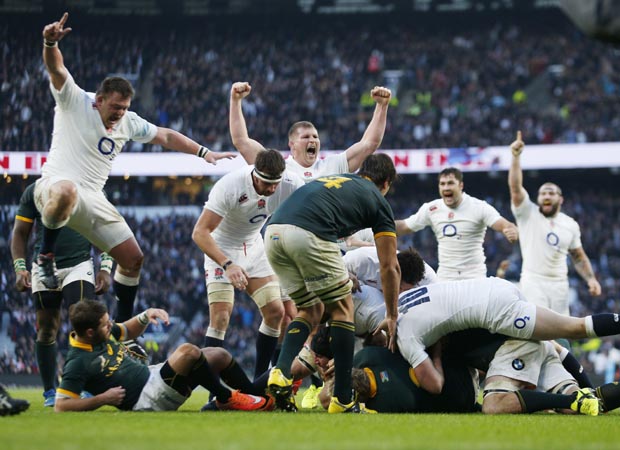
 My New Year’s rugby resolutions start with a return to rucking. To this day I don’t understand why rucking ever changed. I’ve never seen any statistics that suggested that rucking was so dangerous that it had to go.
My New Year’s rugby resolutions start with a return to rucking. To this day I don’t understand why rucking ever changed. I’ve never seen any statistics that suggested that rucking was so dangerous that it had to go.
In my era, forwards wore studs which stretched the laws, and it was mainly to ruck the legs and backs of opposition players who got on the wrong side of the breakdown. I heard of very rare occasions when scrotums were split, and was on the pitch when Phil de Glanville and Stuart Barnes got scalp wounds, but overall I can remember only a handful of ruck incidents over a period of 15 years as a player.
We’re told that the ban on rucking came about because of health and safety issues, but in that case you should also have no scrums, no lifting at the lineouts, and no jumping for high balls. Also, I’m sure that if you asked players about 99 per cent would say they would have the ruck back in rugby.
The benefits were very quick ball, chiefly because you wouldn’t get people falling on the wrong side if they knew they were going to be rucked. It forced you to get out of the way quickly.
If rucking was still allowed the breakdown would be a lot cleaner than the mess we have now. The ruck laws were clear that you stepped over the man and drove the bodies out backwards. Although you still got the occasional silly stamp, that’s no different to what it is now when Dylan Hartley trod on Duane Vermeulen.
My next bugbear is why TMOs have not yet got the wording right between themselves and the referee. “Is that a try, yes or no,” is too open. Refs should grow a pair of balls and say, “is there a clear and obvious reason why I shouldn’t award a try?”
The wording in the TMO protocol is that decisions should be clear an obvious, remember this is a trial period, and don’t be afraid to change it. We should use technology even though it’s not failsafe – but let’s speed it up and make the whole process more professional.
Let’s work within what’s available, and work quickly and efficiently – but the wording is the key thing. At the moment it’s embarrassing because some referees just chuck any decision across to the TMO rather than leading the decision-making process.
You cannot put the genie back in the lamp, but you can certainly make better use of it. I’m amazed that it hasn’t worked better, but my advice is that if you need to tinker with it, then tinker with it now.
Another new trend I’m not so keen on is the shouting and pointing at referees, but players think they can get away with it because referees talk to them so much more than they used to. A lot of chat is unnecessary, and maybe referees should do less of it. Let the captain ask questions, but the rest should be quieter.
Next, the scrum. We reached the point when enough was enough with collapsed scrums and resets some time ago, but no-one has sorted it out, and it can’t go on. The scrum is an important part of our game with a big influence, and it is also one of the most technical aspects of it, so it needs to work.
We should look back to the reform of the lineout for guidance because at one time it was also a big problem area, and now it’s much more clear-cut. We get quick, clean ball because there’s a big gap between the lines, the jumper cannot be touched until he hits the ground, and, although the hookers have become a bit cheeky, they generally throw-in reasonably straight.
World Rugby needs to take the same root and branch approach to fixing the scrum. The big problems are too many crooked feeds, hookers not hooking, and scrums taking too long to set. It shouldn’t take more than 10 seconds. They all know where they are meant to bind, at what height they should scrummage, that they are not meant to push before the ball is in, and that the ball should be put-in straight.
All that referees have to do is show a bit of common sense and empathy, but be tough enough to penalise the offenders.
Coaches and players will moan and bitch – but as long as referees are consistent they will get into line. They have to recognise that if they force the referee to make a decision, and it goes against them, then they have to suck it up.
Like the rest of us, referees have different personalities, but the fundamentals at the scrum and lineout should be refereed the same way everywhere in the world.
Referees have to realise that they lose respect by not penalising the basic laws, like a crooked feed. It’s so obvious, that it’s embarrassing. Don’t have it in the rulebook if you’re not going to referee it. If the World Rugby refereeing authorities, along with the individual national Unions’ refereeing bosses, approached the scrum laws as rigorously as they adhere to the dangerous tackles law the scrum would also be in a better place.
I’ve also got a thing with the jackal tackle. The player doing the jackal is often not supporting his own bodyweight (they sometimes support their weight with their hands or all the lower arm from the elbow down) and even if that is for a couple of seconds, it is less acceptable than someone not rolling away immediately.
The breakdown is a very tough area for referees because there are so many scenarios, but this has to be combated. The only way to do this is for the referee and his two assistants to have a plan for every facet of the game.
A legal jackal is a great piece of skill, and brilliant to watch, but teamwork between the officials can identify when they do it illegally and prevent good attacking play by slowing the game down deliberately.
In 2015 referees have got to become stronger-willed and be prepared to reaffirm to players and coaches what the laws are.


Latest News
Super Rugby Americas: Round Ten Review

British and Irish Lions
British and Irish Lions: Biggest winners and losers from Andy Farrell’s selection
























You must be logged in to post a comment Login